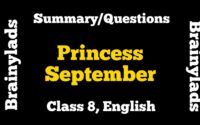Ancient Education System of India Summary | Class 8 | Questions Answers
Table of Contents
Ancient Education System of India Summary | Questions Answers
Brief Introduction of Ancient Education System of India
The Ancient Education System of India discusses the evolution of the education system in India. It talks about different types of information, and it tells us that education has been around in India since ancient times. You can see this evidence in that there are stone inscriptions, palm leaf records, and metal engravings all over the country. There were also ancient institutions for educating people, and they were focused on helping students learn skills.
Summary of Ancient Education System of India
Ancient Education System of India Summary : People from many different countries came to visit India. They wanted to explore the Indian culture, religions, philosophies, art and beauty. The Indian education system is focused on developing the inner self of each person along with their outer self. It encourages values like honesty and humility.
The education system was designed to develop students in many ways. It focused on their physical, mental, and intellectual development as well as their moral development. The ancient education system was based on the teachings of the Vedas and Upanishads which teach people how to take care of themselves, their families, and society.
Some other sources of learning were writings by Sushruta and Charaka. There are several branches or disciplines such as Shastras, Kavyas, Itihas, Anviksiki, Mimamsa, Shilpashastra, Arthashatra, Varta and Dhanurvidya from which students learned. Besides physical education was also considered an important co-curricular activity in the form of Krida or recreational games. These were some other disciplines which were taught with dedication and integrity.
Different types of debates between students were organized to see how much they learned. Students were also taught to live a disciplined life, so that they could reach their full potential. Learning and teaching in groups was an important part of school, and it helped students learn more. Different schools give formal or informal education.
In India, schools are temples of knowledge. When people were born, they went to school. It was the best place to get new information and learn new skills. There are also universities for people who want to go higher in their education. In ancient times, there were also women Vedic scholars who taught wisdom through writing.
RELATED
NCERT Solutions of Ancient Education System of India
Comprehension Check (Page 92)
Question 1: Why were travellers attracted towards India?
Answer: One reason people come to India is because of the fame of Indian culture, its wealth, religions, philosophies, art, architecture. The education system in ancient times was seen as a rich source of knowledge that helps guide and encourage humans. For travelers coming to India it is a land of great wonder.
Question 2: What were the sources of the ancient education system?
Answer: The different sources of ancient system of education were the education imparted from the Vedas, Brahmanas, Upanishads and Dharmasutras. The writings of Aryabhata, Panini, Katyayana and Patanjali and the medical treatises of Charaka and Sushruta were also some of the rich sources for learning. Besides that there was also Itihas (history), Anviksiki (logic), Mimamsa (interpretation), Shilpashastra (architecture), Arthashastra (polity) Varta (agriculture or trade or commerce or animal husbandry) and Dhanurvidya(archery).
Question 3: What were the features of education system in ancient India?
Answer: Some features of education system in ancient India are given below
- Teaching and learning follow the tenets of Vedas and Upanishads, which means that if you teach well, you are being good to yourself, your family, and society.
- Education system focused on overall development. It covered both learning and physical development.
- The motive of education was to maintain a healthy mind and healthy body.
- Education in India used to be practical. It was easy to accomplish, and it helped with life.
Question 4: What was the role of guru in pupils’ lives?
Answer: In ancient times, Gurus helped their students. They would have debates to test the students’ knowledge. The Gurus and their shishyas would live together and help each other in everyday life. It was important for the students to learn everything, have a disciplined life, and use their inner potential to become a Guru after they finished school. Students would leave home to go to school. They would stay at the Guru’s house, or gurukul. The students’ goal was to have their goals achieved. The gurukul was where the teacher-student relationship got stronger with time because of many things they learned, including history, art of debate, law, medicine etc.
Comprehension Check (Page 97)
Question 1: Where did the nuns and monks receive their education?
Answer: In the past, nuns and monks got their education from monasteries or viharas. There were many different kinds of these institutes that were set up as places to learn about art and learning. They were mainly to teach people who wanted to find out more about knowledge during the ancient period.
Question 2: What is Panini known for?
Answer: Panini was a great Indian man who was an expert in grammar and language. He wrote one of the best books on grammar, called Ashtadhyayi. This book is very famous in India because it teaches people about grammar. Panini had many skills that are important to learn.
Question 3: Which university did Xuan Zang and I-Qing study at?
Answer: In the 7th century, Xuan Zang came to Nalanda. This is a place where people go to learn more about many different things. It was called Nala when he was here, but now is called Nalanda.
Question 4: Which subject did Xuan Zang study in India?
Answer: Xuan Zang studied Yogashastra, grammar, logic and Sanskrit when he was in college.
Question 5: How did society help in the education of the students?
Answer: During ancient times, knowledge was considered sacred. No one charged for teaching it. Wealthy people gave money to the universities. Some of them also gave buildings or land that they owned. Universities had buildings and land donated by wealthy people during the ancient times, such as Valabhi, Vikramshila and Jagaddala.
Exercise (Page 97)
Discuss the following questions in small groups and write your answers.
Question 1: Which salient features of the ancient education system of India made it globally renowned?
Answer: Some of the salient features of the ancient education system of India that made it globally renowned are given below-
- As our ancient education system in India has changed over the years, it started focusing on the development of individuals. This includes both their inner and outer selves.
- The old and ancient system focused on the spiritual, physical, and moral aspects of life.
- It talked about being honest, being humble, being self-reliant, having discipline and respecting all creative works.
- Students were taught to admire and understand that humans are part of nature.
- Teachers taught and followed the teachings in Vedas and Upanishads that tell you to do what is right for yourself, your family, and society.
Question 2: Why do you think students from other countries came to India to study at that time?
Answer: Many years ago, students came to India to study. They came from countries all over the world, like China and Korea. This was because India was considered to be a land of wonder with many educational centers. Monasteries were set up for monks and nuns where they could meditate, debate and discuss things with other learned people so they could learn more about different things. Besides, Takshashila was a religious place that included teachings about Buddhism. It attracted students from around the world until it was destroyed in the 5th century CE.
Question 3: Why is education considered ‘a way of life’?
Answer: Education is considered ‘a way of life’ because in ancient India, there was the existence of both formal and informal modes of education system. Indigenous education was imparted at home, gurukuls, tols, temples, Pathshalas and chatuspadis. People in homes, villages and temples would guide young children and help them in imbibing the pious and ideal ways of life.
Question 4: What do you understand by holistic education?
Answer: Holistic education is the development of people and how they can be prepared for life. It can help you develop your skills in different areas, like your inner self and outer self. Ancient Indian education systems weren’t free, but they were mostly centered on their rich cultural traditions that helped them with the physical, spiritual, intellectual and artistic parts of their lives.
Question 5: Why do you think Takshashila and Nalanda have been declared heritage sites?
Answer: Takshashila was an ancient Indian city that was declared to be a World Heritage Site by UNESCO in 1980. It is important because it is an archaeological site and also because of the teachers who lived there, who were experts.
Nalanda was one of the oldest universities in the world. It was open for learning from 5th century CE to 12th century CE. UNESCO has declared Nalanda Mahavihara as a World Heritage Site.
Do share this post if you liked Ancient Education System of India Class 8 Summary. For more updates, keep logging on BrainyLads.



